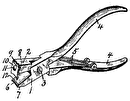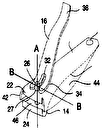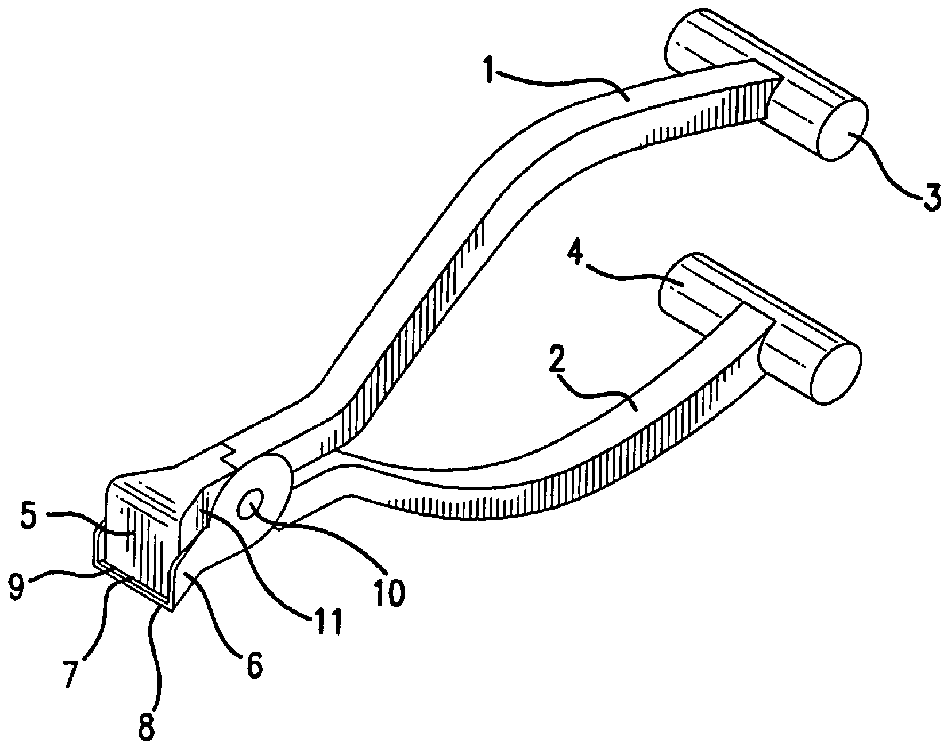
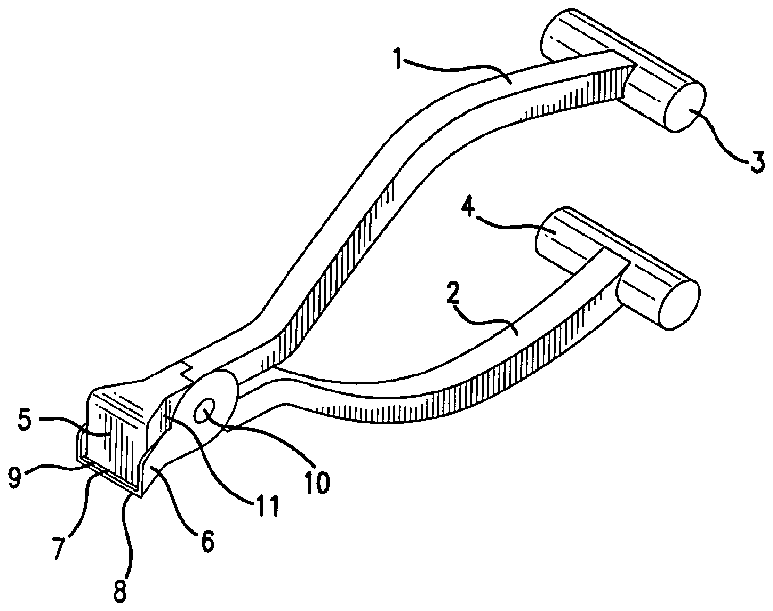
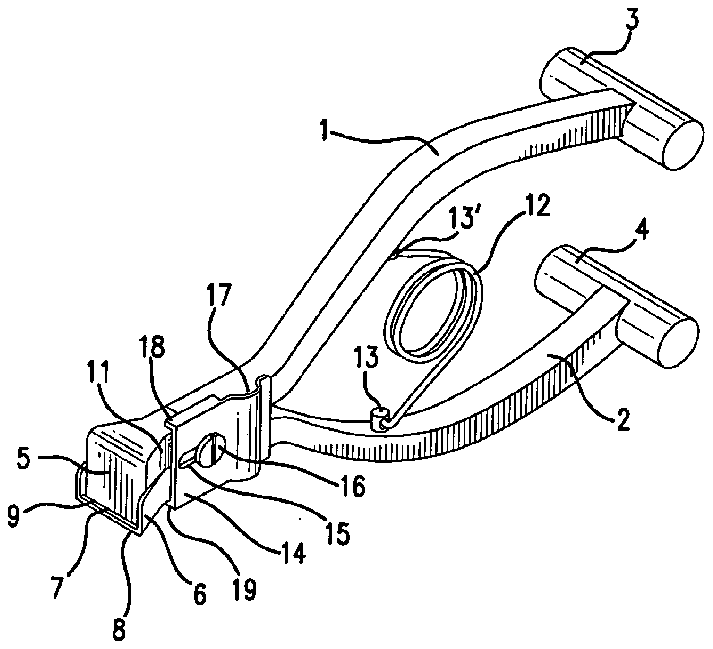
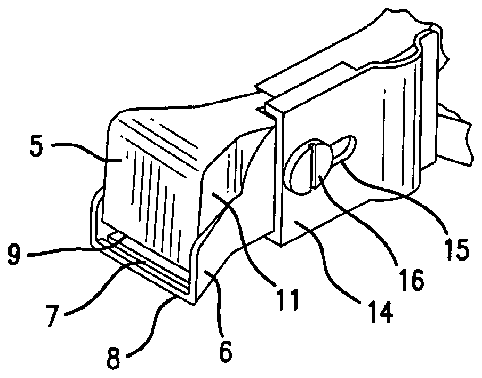
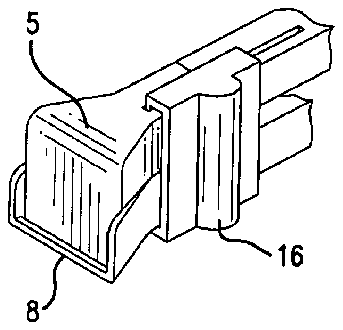
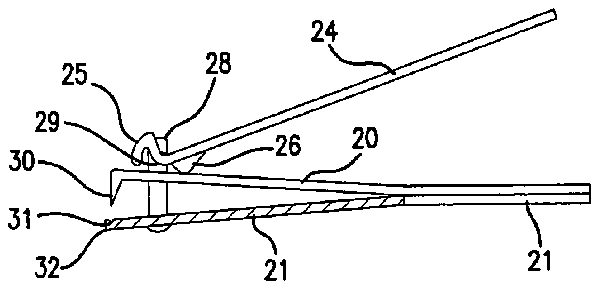
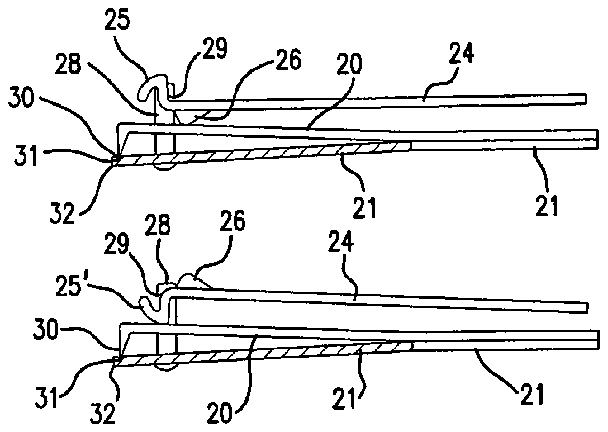
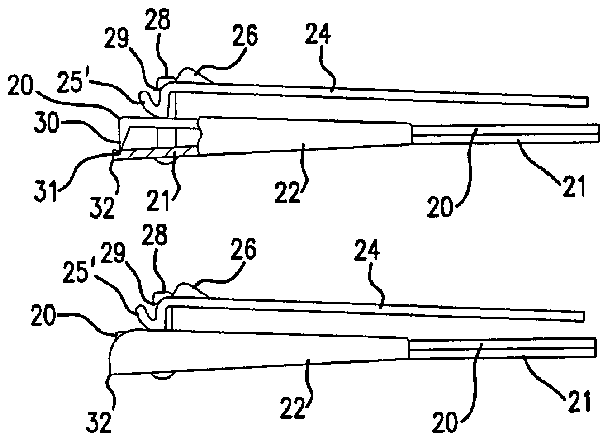
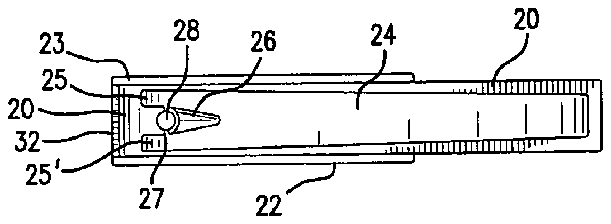
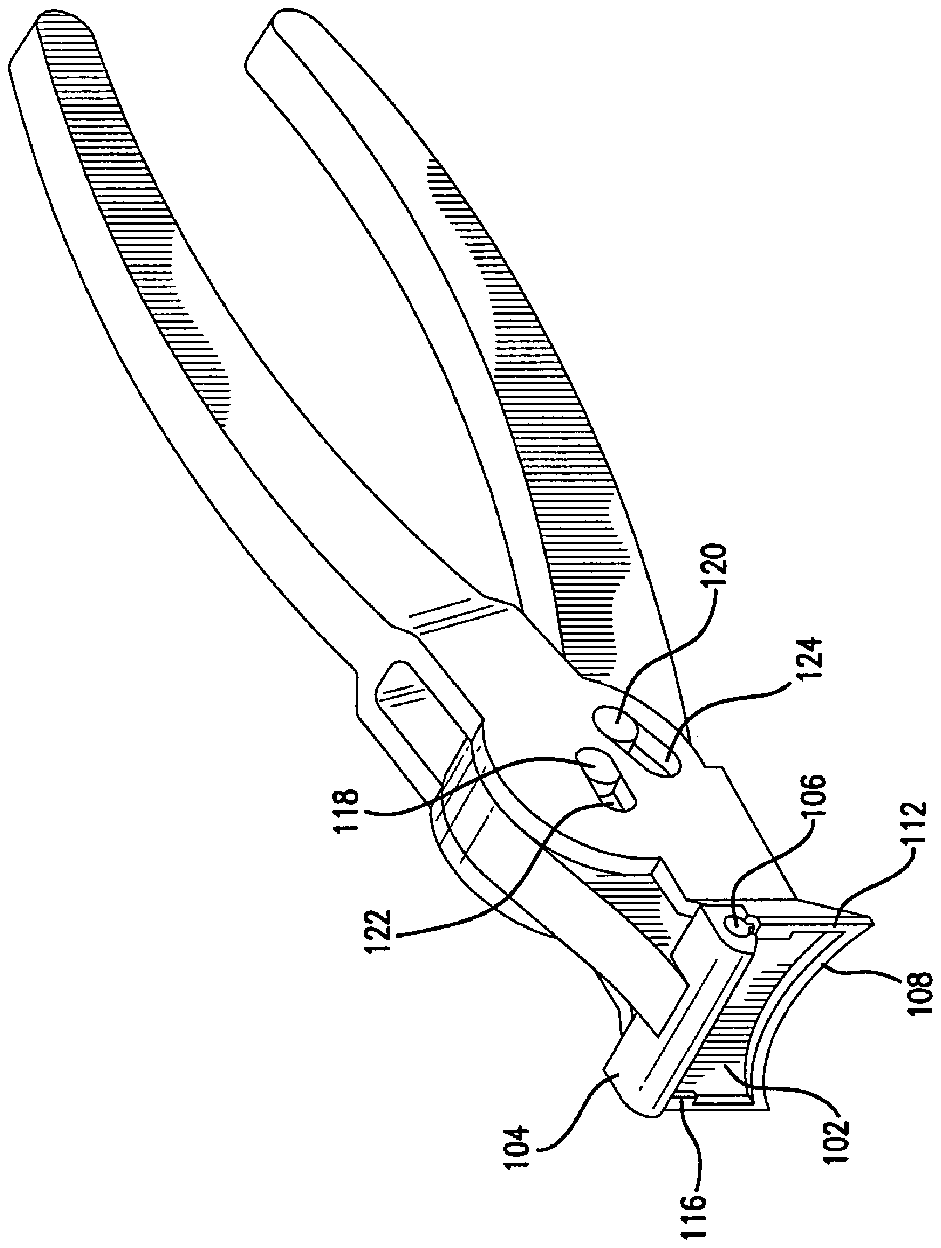
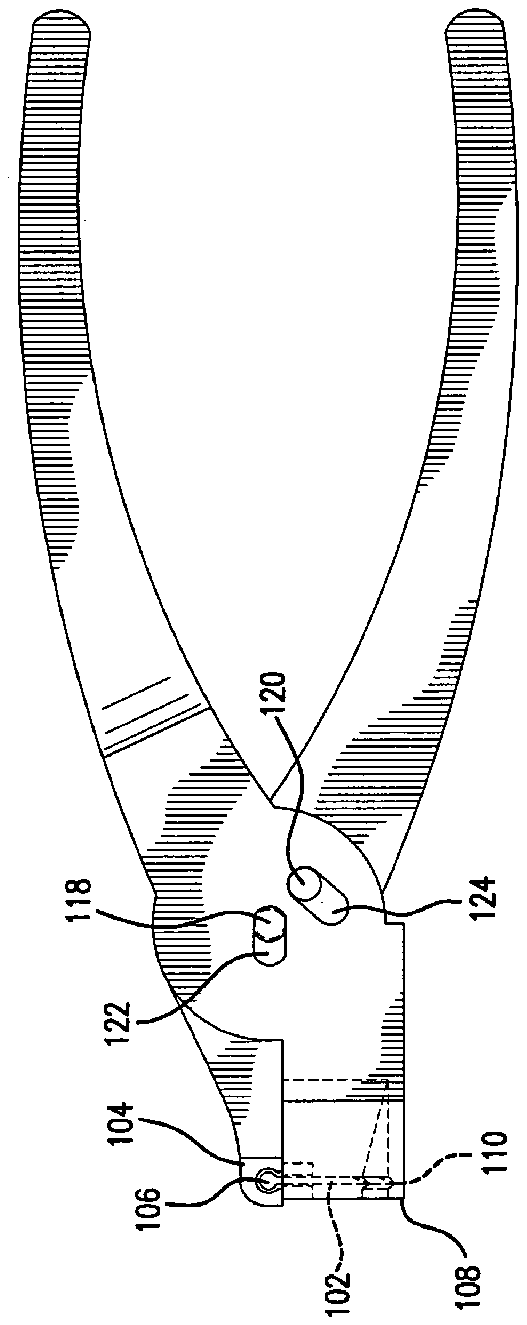
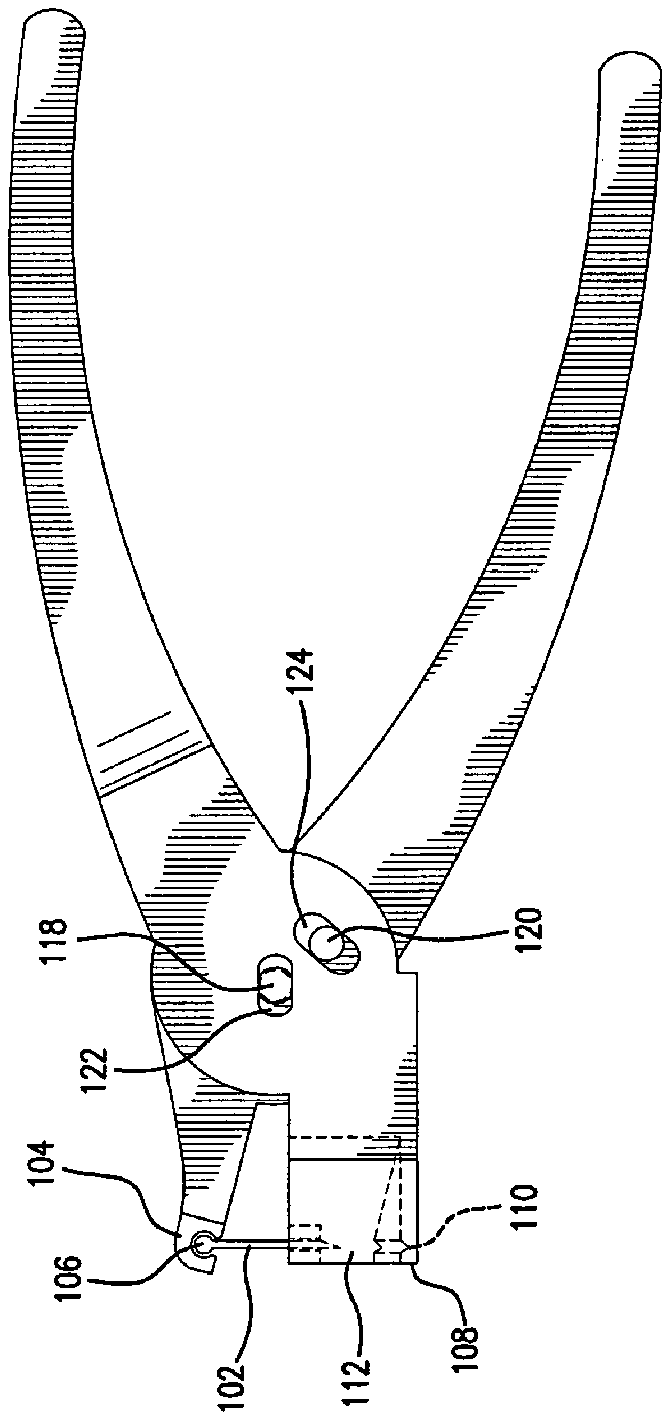
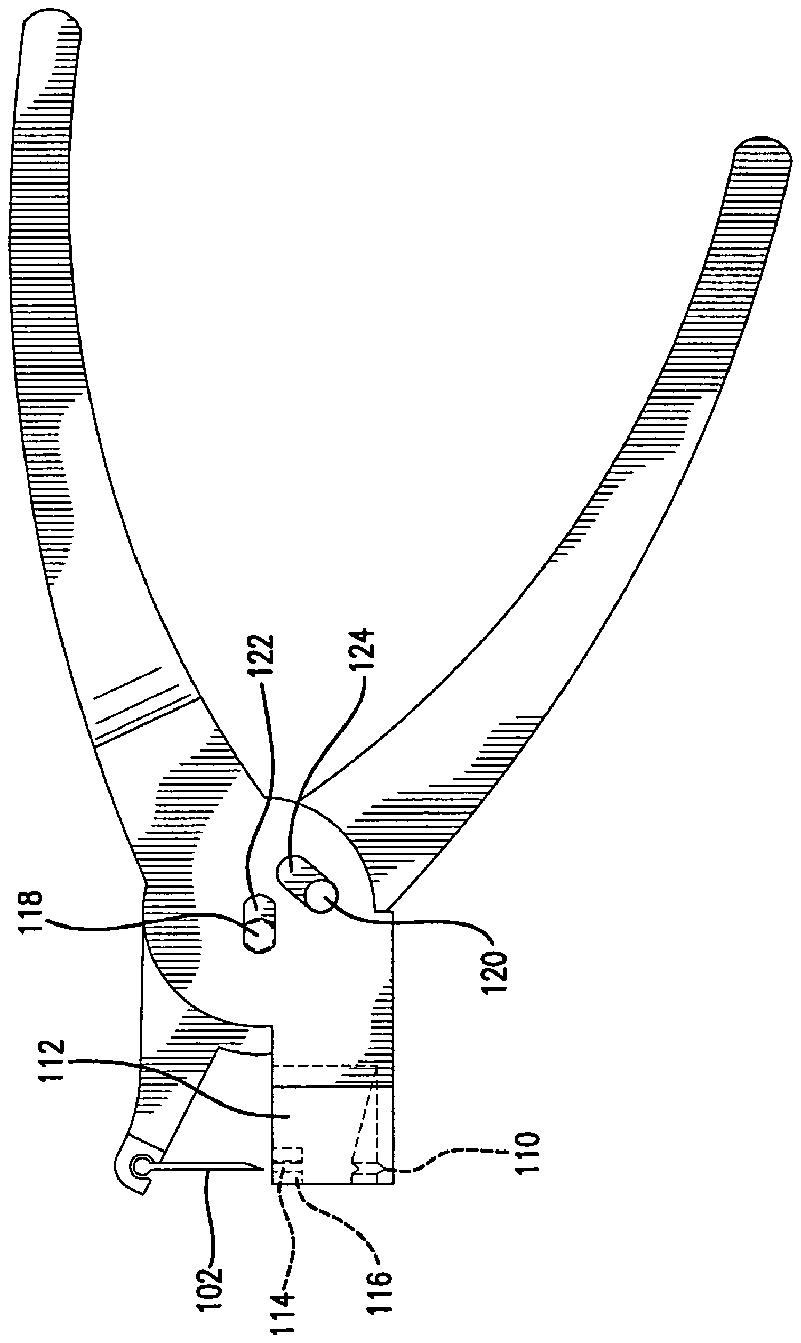
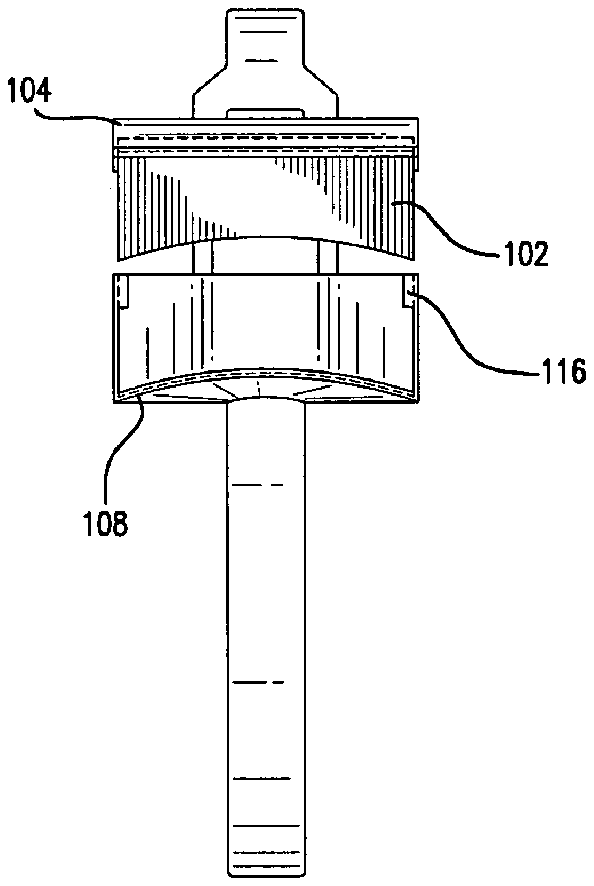
- 1upper handle
- 2lower handle
- 3grip
- 4grip
- 5upper blade
- 6side dams
- 7groove or slot
- 8lower tray
- 9lower edge
- 10pivot point
- 11one side
- 12spring
- 13points
- 14latch
- 15groove
- 16latch
- 17moved rearwardly toward point
- 18point
- 20leaf
- 21leaf
- 22side dams
- 24handle
- 25frontal portion
- 26cam
- 27void
- 28pivot point
- 29guide
- 30upper blade
- 31the upper blade engaging groove or slot
- 32lower tray
- 102blade
- 104upper jaw
- 106pivot point
- 108lower tray
- 110slot
- 112side dams
- 114guide
- 116extension
- 118axle
- 120guide
- 122slot
- 124slot
Abstract
Nail clippers have a lower tray and side dams which extend upwardly from either side of the lower tray. A nail to be cut is positioned between the lower tray and an upper blade. The upper blade is displaced toward the lower tray, and within the side dams, until the upper blade contacts the lower tray, passing through the nail to cut the nail. A front portion of the lower tray extends outwardly and beyond the upper blade when the upper blade is closed against the tray. The nail clippers are structured to prevent injury to the skin and tissue that surrounds the fingernails and toenails to be cut. The nail clippers are particularly efficacious at cutting ingrown nails.
Description
FIELD OF THE INVENTION
[0001] This invention relates to nail clippers.
BACKGROUND OF THE INVENTION
[0002] Nail clippers are known and used in the art. Nail clippers are used to trim fingernails and toenails of humans and other animals. Nail clippers as most commonly known and used in the art have an upper blade and a lower blade, which are substantially identical in architecture. The upper blade and lower blade are displaced towards each other, with the nail to be cut positioned between the blades. The blades are displaced towards each other until contact is made with the nail, and displacement is continued until the nail is divided by the blades, and the blades contact each other.
[0003] In nail clippers known and used in the prior art, the clippers do not provide protection from the cutting blades for skin that is in close proximity to the nail to be cut. Further, in prior art nail clippers, there is no provision for enhancing cutting performance where ingrown nails, and particularly toenails, are involved.
SUMMARY OF THE PRESENT INVENTION
[0004] The present invention is nail clippers that assist in preventing injury to the skin and tissue that surround the fingernails and toenails to be cut. The nail clippers are particularly efficacious at cutting ingrown nails.
[0005] The nail clippers are characterized by a lower tray having side dams that extend upwardly from either side of the lower tray. A nail to be cut is positioned between the lower tray and an upper blade. The upper blade is displaced toward the lower tray, and within the side dams, until the upper blade contacts the lower tray, passing through the nail to cut the nail. A front portion of the lower tray extends outwardly and beyond the upper blade when the upper blade is closed against the tray.
DESCRIPTION OF THE DRAWINGS
[0006] FIG. 1 is a perspective view of the nail clippers of the present invention.
[0007] FIG. 2 is a perspective view of an additional embodiment of the nail clippers of the present invention.
[0008] FIG. 3A is an isolation of the nail clippers of the present invention, emphasizing, inter alia, the lower tray and the upper blade. The upper blade and lower tray are separated, or open in this view, whereas they are together, or closed, in FIGS. 1 and 2 .
[0009] FIG. 3B is an isolation of the nail clippers of the present invention, with the upper blade and lower tray held together, or closed, by a latch.
[0010] FIG. 4 is a partially sectioned side elevation of another embodiment of the nail clippers of the present invention.
[0011] FIG. 5 shows the nail clippers of FIG. 4 , with the upper blade partially displaced toward the lower tray.
[0012] FIG. 6 shows the invention of FIGS. 4 and 5 , with the upper blade fully displaced to the lower tray.
[0013] FIG. 7 shows the nail clippers of the present invention as shown in FIG. 6 , with the lower tray being partially sectioned.
[0014] FIG. 8 is a side elevation of the nail clippers of the present invention, with the upper blade in the position shown in FIG. 6 and FIG. 7 .
[0015] FIG. 9 is a plan view of the nail clippers of the embodiment of FIGS. 4-8 .
[0016] FIG. 10 is a perspective view of an additional embodiment of the nail clippers of the present invention.
[0017] FIG. 11 is a side elevation of the nail clippers of FIG. 10 , with the jaws fully closed.
[0018] FIG. 12 is a side elevation of the nail clippers of FIG. 10 , with the jaws in an intermediate position.
[0019] FIG. 13 is a side elevation of the nail clippers of FIG. 10 , with the jaws fully open.
[0020] FIG. 14 is a front elevation of the nail clippers of FIG. 10 , demonstrating a replaceable blade as a phantom.
DESCRIPTION OF THE PREFFERED EMBODIMENTS
[0021] Turning now to the drawing figures, an embodiment of the present invention is shown in FIG. 1 . The nail clippers comprise an upper handle 1 and a lower handle 2 . A grip 3 may be provided for the upper handle, and a grip 4 may be provided for the lower handle. An upper blade 5 communicates with the upper handle. A lower tray 8 communicates with the lower handle.
[0022] The lower tray has a front portion which extends beyond the upper blade when the upper blade is displaced to contact the lower tray. The upper blade is sharpened on a lower edge 9 , which contacts the lower tray 8 . Side dams 6 extend from each side of the lower tray. The upper blade is positioned fully within each side dam and above the lower tray. A groove or slot 7 may be formed in the lower tray to receive the upper blade.
[0023] Each side dam extends outwardly and beyond the tray as shown in the drawing figures. Each of the side dams extends outwardly and beyond the upper blade, when the blade is closed against the lower jaw, at an angle of 30° to 60° from a centerline drawn longitudinally, or along the length of, the nail clippers, and are preferably at an angle of 45° from a centerline drawn longitudinally, or along the length of, the nail clippers
[0024] The front of the upper blade is generally perpendicular to the lower tray, so that the sharpened lower edge of the upper blade is generally perpendicular as the upper blade meets the lower tray, and/or as the upper blade meets the groove or slot that is formed in the lower tray.
[0025] The handles of the upper blade and the lower blade, are in a pivotal relationship to each other, as provided by pivot point 10 . One side 11 of the upper blade is adjacent to the side dam.
[0026] In the embodiment shown in FIG. 2 , spring biasing is provided by means of spring 12 which is attached to the upper handle and lower handle at points 13 and 13 ′.
[0027] A latch may be provided, as shown in the embodiment of FIG. 2 . Latch 14 has a groove 15 therein in which pin or screw 16 travels. As latch 16 is advanced forwardly, it strikes the upper jaw at point 18 , to close and latch the jaw. To use the device, the latch is moved rearwardly toward point 17 , which releases the jaw. FIG. 3A . For ease of manipulation, the edge of the latch may be scalloped and/or curved as shown. The screw may be used to hold the latch in place as desired. FIG. 3B shows an alternative embodiment of the latch, with the latch 16 mounted within a slot. The latch traverses the slot to lock and unlock the jaw, and limit travel of the jaw as desired.
[0028] In use, the lower tray is inserted underneath the nail to be cut. The front portion of the tray engages the quick of the nail, and aids in alignment. One of the side dams, depending on whether the right edge or the left edge of the nail has skin or other tissue which is to be protected, is used to protect the skin or other tissue. The use of the side dam allows the nail to rest within the side dam, while the tissue is outside the dam.
[0029] The front edge of the lower tray is preferred to be relatively thin, having a dimension of 0.015 mm to 0.040 mm from the blade to the front edge, so that it may be easily inserted underneath the nail.
[0030] The nail clippers cut the nail by the nail being inserted between the upper blade and the lower tray. The upper blade is disposed toward the lower tray by compression of the handles, and travels toward the lower tray and through the nail until the nail is cut. Since the front of the lower tray extends beyond the blade, and the blade is recessed within the tray, and travels within the side dams, the blade cuts the nail only, and does not cut skin or other surrounding tissue. The tray as formed, with the side dams, allows the nail to be placed within the tray, while skin and other tissue are excluded. Since the blade operates only within the tray and is not outside of the tray, or “even” with the tray, upon the nail being properly positioned, only the nail is cut by the clippers, and surrounding skin is shielded by the lower tray and the side dams.
[0031] The embodiment of FIGS. 4 through 9 show a different handle configuration. However, the primary elements of the device are the same as those shown in FIGS. 1 through 3 .
[0032] As shown in FIG. 4 , this embodiment provides an upper leaf 20 and a lower leaf 21 which join each other. A lower tray 32 is provided, which has side dams 22 and 23 . An upper handle 24 is provided which allows displacement of leaf 20 toward leaf 21 , in a conventional manner. Handle 24 has a frontal portion 25 and 25 ′, and a cam 26 . A void 27 permits a pivot point 28 for the handle 24 and leaf 20 . The handle and the upper leaf travel along a length of guide 29 . Upper blade 30 extends from leaf 20 generally perpendicularly and toward the lower tray 32 , with the upper blade engaging groove or slot 31 as shown in FIGS. 6 and 7 . In this “locked” configuration, there is no gap between the blade and the lower tray. The elimination of a gap between the blade and the lower tray helps prevent the blade from tearing clothing and the like when the device is carried in a pocket in this “locked” position.
[0033] FIG. 10 through FIG. 14 show an additional embodiment of the invention. The blade 102 in this embodiment is pivotally mounted to the upper jaw 104 . The blade pivots relative to the upper jaw at a pivot point 106 , so that the blade is generally vertical at all times as it travels relative to the lower tray 108 , and while the lower tray is in the generally horizontal position shown in FIG. 11 through FIG. 13 .
[0034] As shown in FIG. 11 , the upper jaw is displaced fully toward the lower tray. The blade engages the slot 110 within the lower tray. In this embodiment, each of the side dams 112 has a guide 114 formed therein in which the blade travels. In a preferred embodiment, the guide is a slot that is formed in the side dams by an extension 116 that is present on the upper portion of the side dams. As the upper jaw moves toward the lower jaw, the blade strikes the bottom of the groove and limits the travel of the blade. However, if blade breaks, the upper jaw strikes the lower jaw as shown in FIG. 11 , limiting the travel of the upper jaw. In this way, a toe inserted between the jaws is not injured by the jaws if the blade breaks.
[0035] FIG. 12 shows the blade in an intermediate position relative to the lower tray. The blade travels within the slot formed within the side dam, which may be provided by the extension in each of the side dams that are formed in the upper part of the side dam, but not the lower part of the side dams, so that they do not interfere with the insertion of the nail between the lower tray and side dam. The slot guides the blade so that it maintains its generally perpendicular position relative to the lower tray. The pivotal mounting of the blade relative to the upper jaw allows the blade to maintain the generally perpendicular position by allowing he angle between the upper jaw and the blade to change as the upper jaw travels relative to the lower tray. This is further demonstrated by FIG. 13 , wherein the upper jaw is fully retracted from the lower tray and the nail clippers are in the full open position.
[0036] As shown in FIG. 14 , when the nail clippers are in the fully open position, the blade may be removed sliding it out and away from the pivotal mounting. The blade may then be replaced, or perhaps sharpened, as needed.
[0037] As shown in the embodiment of FIG. 10 through FIG. 14 , the pivotal mounting that provides the pivoting relationship between the upper jaw and lower tray is comprised of an axle 118 , and controlled by a guide 120 . The travel of the guide is directed by slot 124 , which forces the upper jaw forward as the upper jaw raises, and retracts it rearwardly as the upper jaw is displaced down and toward the lower tray. This guide maintains the forward end of upper jaw, where the blade is mounted, directly above the guide for the blade that is present in the side dams, whether the nail clippers are fully closed ( FIG. 11 ), in an intermediate position ( FIG. 12 ) or in a fully open position ( FIG. 13 ).
[0038] In order for the guide to control the position of the upper jaw relative to the lower tray, the axle must traverse a slot 122 . This feature is demonstrated as the nail clippers move through the positions shown progressively in FIG. 11 , FIG. 12 and FIG. 13 . The axle moves from a rearward position to an intermediate position to a full forward position as the guide controls the movement of the upper jaw relative to the lower tray. In the preferred embodiment, the axle has a flat upper surface and a flat lower, and opposite, surface. The flat surfaces provide a larger surface for the substantial loads or pressures that are placed upon the axle when the nail clippers are in the fully closed position, and pressure is applied to cut a nail, such a dense toenail.
[0039] Nails are typically curved at the end. The lower tray has a convex upper surface over which the nail is received for cutting. FIG. 14 . The curved lower tray provides support for the nail as the end of the nail is severed by the blade, providing a more efficient cut. The upper blade has a concave shape at the edge of the blade that conforms to the geometry of the lower tray, with substantially the same arc as the lower tray so that the blade contacts the lower tray at all points to cut the nail.
